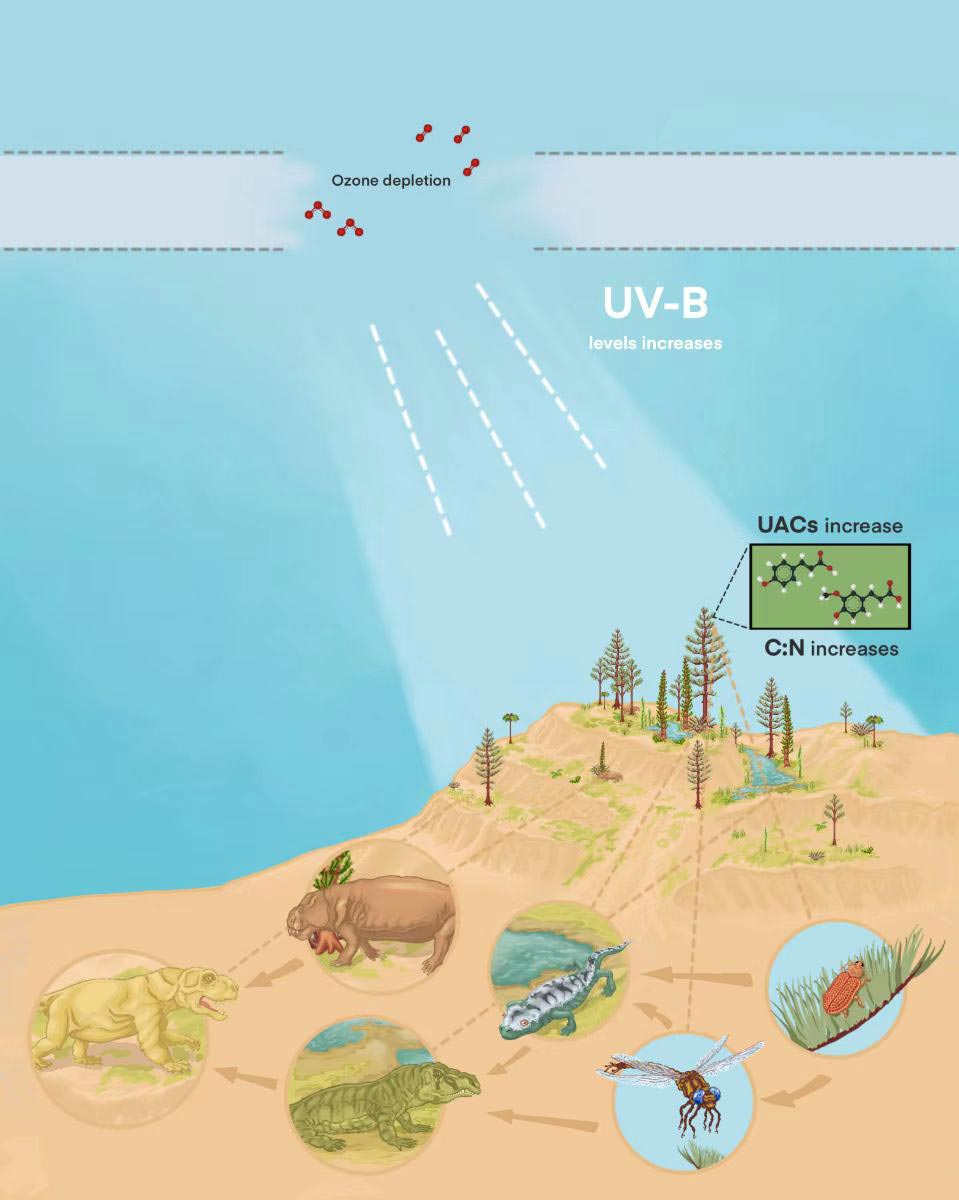Surge evidencia de ‘protector solar’ de polen fósil
1 min read
Los impactos del agotamiento de la capa de ozono y los niveles elevados de UV-B en el ecosistema de la Tierra. Crédito: Conor Haynes-Mannering, Universidad de Nottingham
Científicos de China, Alemania y el Reino Unido dirigidos por el profesor LIU Feng del Instituto de Geología y Paleontología de Nanjing de la Academia de Ciencias de China (NIGPAS) han revelado que el polen conservado en rocas antiguas de 250 millones de años contiene abundantes compuestos que funcionan como protector solar. pero son producidos por las plantas para protegerse de los dañinos rayos ultravioleta (UV-B).
La presencia de estos compuestos sugiere que un pulso UV-B desempeñó un papel esencial en el evento de extinción masiva del Pérmico tardío.
El estudio fue publicado en species. This catastrophic loss of biodiversity resulted from a palaeoclimate emergency triggered by continental-scale volcanism that covers much of modern-day Siberia. The volcanic activity drove the release into the atmosphere of massive amounts of carbon that had been locked up in Earth’s interior, thus generating large-scale greenhouse warming.

Alisporites-type fossil pollen recovered from Permian-Triassic transitional deposits in the Qubu section. Credit: NIGPAS
Accompanying this global warming event was a collapse of the Earth’s ozone layer. Support for this theory comes from the abundant occurrence of malformed spores and pollen grains that testify to an influx of mutagenic UV irradiation.
Plants require sunlight for photosynthesis but need to protect themselves and particularly their pollen from the harmful effects of UV-B radiation. “To do so, plants load the outer walls of pollen grains with compounds that function like sunscreen to protect vulnerable cells to ensure successful reproduction. Without the ‘sunscreen’ compounds, forests could have been sterilized, leading to the collapse of the terrestrial ecosystem,” said Prof. Barry Lomax from the University of Nottingham.
“We have developed a method to detect these phenolic compounds in fossil pollen grains (Alisporites-type) recovered from southern Tibet and detected much higher concentrations in those grains that were produced during the end-Permian mass extinction and peak phase of volcanic activity,” said Prof. LIU.
The researchers found an increase in UV-B-absorbing compounds (UACs) that coincided with a spike in mercury concentration and a decrease in carbon isotopes in the latest Permian deposits, suggesting a close temporal link between large-scale volcanic eruptions, global carbon- and mercury-cycle perturbations, and ozone-layer disruption.
Elevated UV-B levels exerted far-reaching and long-lasting impacts on the entire Earth system. Recent modeling studies have demonstrated that elevated UV-B stress reduced plant biomass and terrestrial carbon storage, thus exacerbating global warming.
In addition, increased concentration of phenolic compounds also makes plant tissue less easily digestible, making a hostile environment even more challenging for herbivores.
“Volcanism on such a cataclysmic scale influences all aspects of the Earth system, from direct chemical changes in the atmosphere, through changes in carbon sequestration rates, to reducing the volume of nutritious food sources available for animals,” said Dr. Wes Fraser from Oxford Brookes University.
For more on this research, see New Discovery Reveals UV Radiation Played a Part in Mass Extinction Events.
Reference: “Dying in the Sun: direct evidence for elevated UV-B radiation at the end-Permian mass extinction” by Feng Liu, Huiping Peng, John E. A. Marshall, Barry H. Lomax, Benjamin Bomfleur, Matthew S. Kent, Wesley T. Fraser and Phillip E. Jardine, 6 January 2023, Science Advances.
DOI: 10.1126/sciadv.abo6102

“Increíble aficionado a la música. Estudiante. Empollón empedernido del café. Jugador. Especialista web aficionado. Pionero malvado de la cultura pop”.


